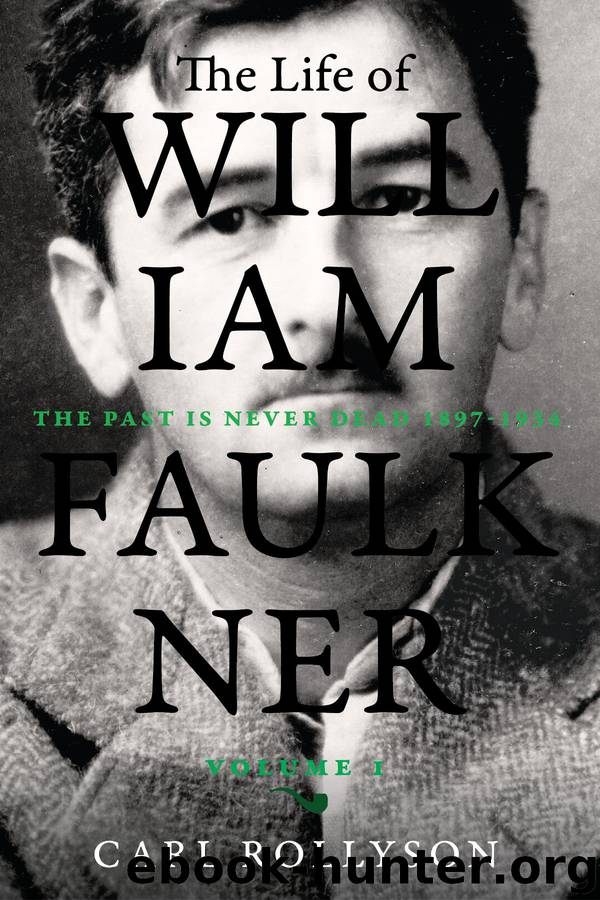The Life of William Faulkner by Rollyson Carl;

Author:Rollyson, Carl;
Language: eng
Format: epub
ISBN: 6027095
Publisher: University of Virginia Press
Published: 2019-12-18T16:00:00+00:00
White beaches and starlight,
The sea was beckoning me
To a place that man might
call lonely
But it means all heaven to me
To my beach—with its surf and
Its wind-swept palms
And the feel of your loveliness
In my arms
With the God of true-lovers to
stay with us always
On my white beach neath
The low tropic stars.27
Cho-Cho’s daughter, Vicki, always believed the poem—more of a song Estelle used to sing at the piano—was written for William Faulkner, luring him to that beach of beauty she had first seen in Hawaii.28 And yet, as Cho-Cho said of her stepfather, “He could say things that cut you to the heart.”29 What had he said to Estelle? And was it something like what he had written in Sanctuary?
Did the horrifying tale of Temple Drake’s rape shake up the marriage at its very start? On May 25, less than a month before his marriage, Faulkner completed a draft of the novel. It infuriated Estelle. She called it horrible. “It’s meant to be,” he said. “It will sell.”30 Horace Benbow imagines marrying Belle Mitchell, a divorcee, in a ceremony that “neither promised nor meant any new emotional experience.” She wears her second husband “like a garment whose sole charm for her lay in the belief that no other woman had one exactly like it.” The novel nudged even closer to Estelle in having Temple wear a one-hundred-dollar imported “Chinee robe.”31 Marriage itself seems second-best: “Any woman makes a better mistress than she does a wife.” The passage most hostile to Estelle occurs in Horace’s letter to his sister Narcissa, when he expatiates on the “unfailing aptitude of women for coinciding with the emotional periphery of a man at the exact moment when it reaches top dead center, at the exact moment when the fates have prized his jaws for the regurgitated bit.” Marriage had bridled Faulkner, notwithstanding his efforts to avoid it. Was that his point?
The shocked women in Hal’s Smith office—all of whom had supported Faulkner’s work—argued against publication. Smith concurred, telling Faulkner: “Good God, I cant publish this. We’d both be in jail.”32 Faulkner said he forgot about the book until the galleys arrived in November 1930, which is hard to believe, given Estelle’s reaction and what they both knew about her own stories. She had created Edna Earl, who forsakes her southern belle imposture for a forthright sexual desire and then, ironically, is defended by white men, representatives of a corrupt society, who think that a foreigner, Chang, has defiled her. So what angered Estelle about her husband’s work? The graphic nature of Temple’s rape, the raw desire Temple expresses for sex with another lover, Red? “I cant wait. You’ve got to. I’m on fire, I tell you,” Temple cries as she clings to Red. Is it the intense carnality of the novel that went beyond Estelle’s notions of proper literature? Whatever the trouble between the newly married couple, it is hard to suppress the thought that the quarantined Sanctuary continued to ferment in Faulkner’s imagination, especially since Smith intended to publish the novel all along—no matter how risky that might seem.
Download
This site does not store any files on its server. We only index and link to content provided by other sites. Please contact the content providers to delete copyright contents if any and email us, we'll remove relevant links or contents immediately.
| Books & Reading | Comparative Literature |
| Criticism & Theory | Genres & Styles |
| Movements & Periods | Reference |
| Regional & Cultural | Women Authors |
4 3 2 1: A Novel by Paul Auster(11800)
The handmaid's tale by Margaret Atwood(7459)
Giovanni's Room by James Baldwin(6818)
Big Magic: Creative Living Beyond Fear by Elizabeth Gilbert(5360)
Asking the Right Questions: A Guide to Critical Thinking by M. Neil Browne & Stuart M. Keeley(5360)
Ego Is the Enemy by Ryan Holiday(4963)
On Writing A Memoir of the Craft by Stephen King(4668)
The Body: A Guide for Occupants by Bill Bryson(4590)
Ken Follett - World without end by Ken Follett(4449)
Bluets by Maggie Nelson(4268)
Adulting by Kelly Williams Brown(4239)
Eat That Frog! by Brian Tracy(4165)
Guilty Pleasures by Laurell K Hamilton(4124)
White Noise - A Novel by Don DeLillo(3834)
The Poetry of Pablo Neruda by Pablo Neruda(3821)
Fingerprints of the Gods by Graham Hancock(3742)
Alive: The Story of the Andes Survivors by Piers Paul Read(3737)
The Book of Joy by Dalai Lama(3704)
The Bookshop by Penelope Fitzgerald(3622)
